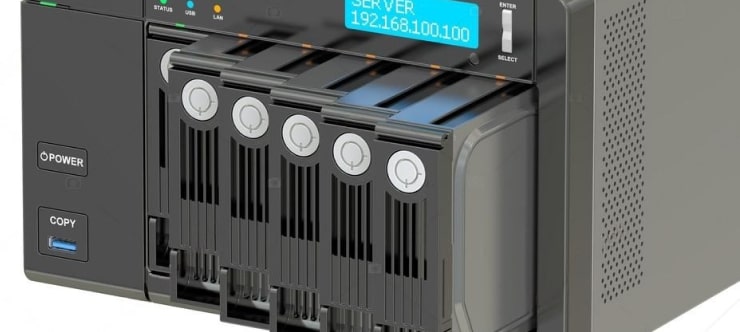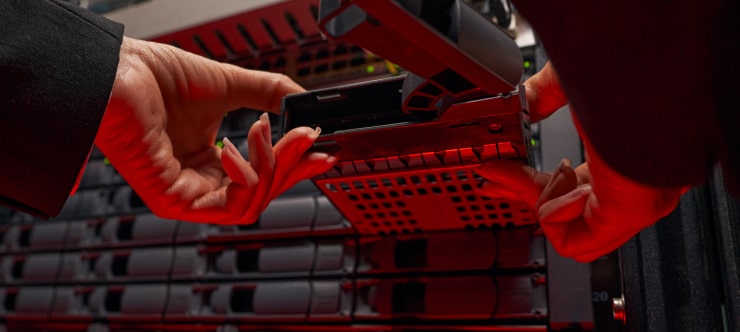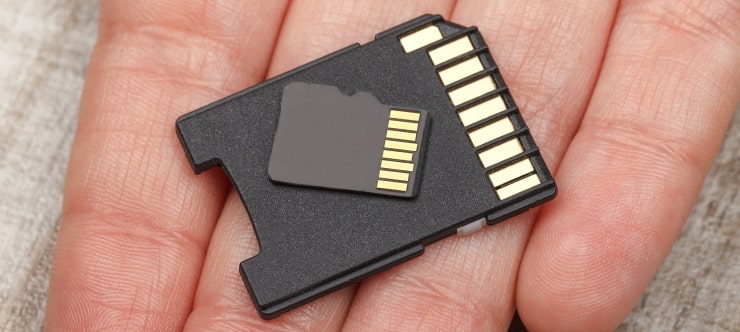Top 8 Common Ransomware Infection Methods

I think there's an issue with my storage device, but I'm not sure
Start a free evaluationRansomware infection can happen in many ways. Most of the time it happens in what appears to be legit situations. For example, hackers pose as real companies, convincing users to click malicious links or download contaminated attachments.Looking to increase their profits, over the recent years, attackers have changed their tactics in favor of methods that are more sophisticated and simple in realization, such as cyber extortion.In a tactic known as double extortion, cyber criminals not only encrypt the victim's data but also exfiltrate it. Then, they demand payment or they leak the stolen data, usually sensitive data.Hacker groups target enterprises, medium and small sizes companies, as well as government organizations, schools, and healthcare facilities, rather than individual users.
8 common ransomware infection methods
Once you know how ransomware attacks happen, you can work to prevent them. Training your staff in cybersecurity best practices is the best way to safeguard your business or organization's sensitive and critical data.
1. Phishing Emails
One of the most effective and common ways of ransomware distribution is through emails containing malicious attachments or links, known as fishing emails. This is also part of the Social Engineering cyber attack method.

The file can be delivered in a variety of extensions, including Word documents, Excel spreadsheets, ZIP or PDF files, and more. Once the infected attachment is opened, an exploit kit is installed. Then, attackers trigger it, infecting the victim’s system and encrypting files.Moreover, the more credible the email looks, the more likely the recipient will open the attachment. Yet, it’s possible to detect a phishing email as it usually has several grammar errors.
Phishing prevention tips
- Make sure the sender’s data (email address, domain, display names, etc) is correct.
- Open attachments from trusted senders only.
- Avoid opening attachments that require you to enable macros.
- Consult with your IT department in case you are unsure about the attachment being legitimate.
- Install email blockers to detect spam and malicious attachments.
2. Malicious Links
Another Social Engineering cyber attack method is to convince users to click on malicious links. For this, cybercriminals will use social networks and media platforms as a means of distributing ransomware.For that, hackers would insert malicious links into messages, or simply leave them somewhere in the comment section. They also can pose as stores and convince users into clicking their links to buy their merchandise.Created in a way that evokes a sense of urgency or intrigue, those messages can easily encourage incautious users to follow malicious URLs. Once downloaded onto the victim’s computer, the ransomware will hold their data encrypted until a ransom is paid.
Malicious links prevention tips:
- Be vigilant about any links embedded into emails or direct messages.
- Don’t click on advertisements on social media pages. If you like the product, look for it online and read the store reviews
- Before following a link, bother to double-check URLs by hovering over it.
- Manually enter URLs into your browser in order to avoid clicking on phishing links.
3. Drive-by Downloads
A drive-by download attack refers to situations where malicious code gets downloaded to your system without your knowledge.To do so, ransomware distributors either inject it into legitimate websites by exploiting known security flaws, or, more rarely, host the malicious content on their own site. At a technical level, this means that when you visit an infected site, the malware it contains automatically analyzes your computer or other device for specific vulnerabilities. Then, it executes the malicious code in the background, gaining access to your system.The worst part about drive-by downloads is that this method, unlike many others, doesn’t require any input on behalf of the user. You don’t have to install or click on anything, and you don’t have to open malicious attachments. All it takes for your system to become infected is to visit an infected website.
Drive-by downloads prevention tips
- Keep all your software up-to-date and regularly check for the latest security updates.
- Install a credible ad-blocker.
- Remove browser plugins if they are no longer in use.
4. Malvertising
Malicious advertising attacks take advantage of the same tools used to show legitimate ads on the Internet. Typically, cybercriminals purchase ad space and link it to an exploit kit. They make it attractive for web page visitors to follow with an attractive offer, provocative image, urgent message, or anything similar. Just like regular online ads.As the user clicks the ad, the exploit kit immediately scans their system for information related to the operating system, installed software, browser specifications, and more.As soon as the exploit kit detects a security flaw (any vulnerability) in the user’s machine, it installs the ransomware on it.
Malvertising prevention tips
- Always keep your operating system, software, and browsers up-to-date.
- Disable unnecessary plugins.
- Enable click-to-play plugins that prevent Flash and Java plugins from running automatically.
- Don’t open online advertisements. Instead, look for the store or product and check its references.
5. Remote Desktop Protocol
Another popular attack vector is unsecured Remote Desktop Protocol (RDP). This is a communication protocol that allows users to link to another computer over a network connection.By default, RDP receives connection requests through a port, which cybercriminals exploit by using scanners to scour the web for systems with exposed and vulnerable ports.Then, by exploiting security vulnerabilities found in targeted machines or using brute force attacks to crack users’ login credentials, cybercriminals gain access to the computer.Hackers then disable anti-viruses, delete backups, and spread the ransomware across the network through lateral movement. The danger here is that they can hide a backdoor to a future attack.
RDP prevention tips
- Use strong passwords.
- Use a VPN.
- Enable 2FA for remote sessions.
- Secure the RDP port.
- Segment the network to prevent lateral movement in case of a cyber attack. Adhere to the Principle of Least Privilege
6. Compromised Credentials
Compromised credentials are login credentials, such as usernames and passwords, that have been stolen or obtained by attackers through various means. This includes phishing attacks or data breaches.Hackers can exploit compromised credentials to infect a system with ransomware through:
- Brute force attacks. Attackers can use compromised credentials to launch brute-force attacks against systems or networks. It involves trying multiple combinations of usernames and passwords until the correct one is found. Once the attacker gains access to the system or network, they can install ransomware.
- Credential stuffing. Attackers can use automated tools to test compromised credentials on multiple websites and applications. If the same username and password are used across multiple sites, the attacker can gain access to those sites and install ransomware.
- Phishing: Attackers can use compromised credentials to send phishing emails that appear to come from a legitimate source, such as a bank or social media site. The emails may contain a link to a website that installs ransomware on the victim's computer.
Compromised credentials prevention tips
- Use strong passwords.
- Implement multi-factor authentication (MFA)
- Educate employees.
- Monitor network activity.
- Update software.
- Implement a password manager
- Patch network vulnerabilities
7. Pirated Software
Plenty of cracked programs come bundled with adware or hidden malware. You can never tell for sure what has been actually downloaded onto your machine once you click the button.While a cracked program offered for free may save you a handful of money, unlicensed software never gets security patches and official updates from the developer. Using pirated software thus dramatically increases the risk of ransomware infection. In addition, websites that host pirated software are more likely to be susceptible to drive-by downloads or malvertising.
Pirated Software prevention tips:
- Don’t pirated and cracked software.
- Avoid visiting websites that are hosting it (including cracks or key generators).
- Be careful about offers that seem too good to be true.
8. Software Vulnerabilities
Software vulnerabilities are weaknesses or flaws in software code that attackers exploit to gain unauthorized access to a system or network. Hackers take advantage of security weaknesses in not patched or updated software.Many ransomware attacks are successful because organizations fail to patch or update their software in a timely manner.Hackers also take advantage of zero-day vulnerabilities. These are vulnerabilities that are unknown to the software vendor and have not yet been patched.
Software vulnerabilities prevention tips
- Patch and update software
- Limite user access privileges
- Implement network segmentation
- Use application whitelisting to control which programs can run on a system
- Use strong passwords
- Install antivirus software and firewalls
How to secure your business against ransomware?
There are many steps that businesses can take to protect themselves from ransomware. Prevention measures include:
- Implement robust anti-spam and anti-malware solutions
- Educate employees about phishing emails
- Keep systems up-to-date with the latest security patches
Robust anti-spam and anti-malware solutions can help to prevent phishing emails and drive-by downloads from infecting computers.Educating employees about phishing emails can also help to reduce the chances of ransomware attacks since they can recognize attackers’ strategies. Employees then will identify phishing emails and not open attachments or click on links from unknown senders.Finally, keeping systems up-to-date with the latest security patches can help to prevent known vulnerabilities from being exploited.By taking these measures, you can significantly reduce the risk of your business being infected with ransomware.
TL; DR: There are several ways ransomware can get inside your company’s system and infect your system. Make sure everyone knows how to prevent their computer from being infected and use high-security technology to protect the data.
How to salvage your data after a ransomware attack
If your business suffered a ransomware attack and you don’t have a backup or need help removing the ransomware and eliminating vulnerabilities, you should contact a data recovery service.Paying the ransom does not guarantee your data will have the data back. The only guaranteed way you can restore every file is if you have a backup of it. If you don’t have a recent backup, ransomware data recovery services can help you decrypt and recover the files.SalvageData experts can safely restore your files and guarantee Clop ransomware does not attack your network again.Contact our experts 24/7 for emergency recovery service.
Related services
These are the most commonly requested data recovery services. At our headquarters' cleanroom lab, our certified engineers conduct a thorough review of any type of physical storage device, determining if there is logical or physical damage and carefully restoring all of the lost files.ces.

External Drive Data Recovery
We recover data from both external SSD and HDD drives. Rely on certified experts to restore your important files from damaged or corrupted external drives.

Hard Drive Data Recovery
Recover data from all brands of HDD, PC hard drives, and hybrid disks. Our specialists ensure fast and secure recovery for any data loss scenario.

NAS Data Recovery
Recover data from NAS devices, including RAID configurations. Our team handles all types of NAS systems and ensures data recovery with minimal downtime.

RAID Data Recovery
Our RAID data recovery services cover RAID 0, 1, 5, 10, and other configurations. We offer expert solutions for failed, degraded, or corrupted RAID arrays.

SAN Data Recovery
Our team specializes in handling SAN devices from leading manufacturers like Dell EMC, HP, and IBM, ensuring efficient recovery with minimal disruption to your operations.

SD Card Data Recovery
Our recovery experts specialize in restoring data from SD and memory cards. We guarantee quick recovery with a no-data, no-charge policy.

SSD Data Recovery
Our data recovery experts handle all SSD data loss scenarios with advanced tools, ensuring maximum recovery with high-security protocols.

USB Flash Drive Data Recovery
Recover lost data from USB flash drives, regardless of the damage or brand. We offer free in-lab evaluations to assess data recovery needs.
If you’re unsure about which data recovery service to choose, let our team assist you in selecting the appropriate solutions. We understand the anxiety that comes with a sudden drive failure, and we are more prompt in our actions compared to other recovery service providers.



